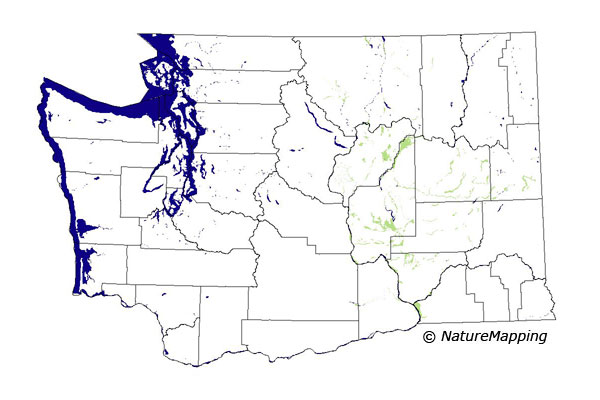


Redhead (Aythya americana) Description: Males in breeding plumage have a gray body, black rump and breast, and a bright rufous head with a yellow eye and a light blue bill with a black tip (see photo). When males are in non-breeding plumage (from July to September) they are dark brown, but still have a dull reddish head. Female and juvenile Redheads are brownish-gray overall, with gray legs, black eyes and a gray bill with a black tip. (BirdWeb)
Calls:
The male courtship call is a catlike "meow." Range: This species is common in freshwater ponds, lakes, wetlands, and slow-moving rivers at low elevations over much of eastern Washington. After the Mallard, the Redhead is generally the most common duck of the Columbia River, but it is apparently rare or absent in much of the southeastern and southwestern Columbia Basin. It probably also breeds north along major river valleys in northeastern Washington. Redheads are a rare and local breeder in Washington. Habitat: Redheads nest near marshy freshwater lakes, ponds, rivers and wetlands in prairie zones. During migration they gather on large lakes and spend the winter on sheltered saltwater bays and estuaries. Click the range map to learn more about the distribution of Redhead in Washington. Diet: Redheads feed by "dabbling" and upending, meaning that they tip their bodies into water, bill first, tail in the air to reach below the surface with its bill in the shallows of ponds, lakes, streams and swamps. Their diet consists of leaves, stems, seeds and roots of aquatic plants. Aquatic invertebrates are also eaten, especially during the summer. Nesting: Redheads build nests close together in dense marshes, especially in areas with dense bulrush, near shallow water or on dry land. The clutch size usually ranges between 6-14 eggs that the female incubates for about 23-29 days. The ducklings are lead to water as soon as their soft, downy feathers are dry and they first fly about 60-65 days (2 months) after hatching. Behavior: Redheads typically gather in small flocks, sometimes mixed with other duck species. In the winter they known to congregate in huge flocks, comprised of tens of thousands of birds. Did you know?
More information: BirdWeb: Redhead
All About Birds: Redhead photos by Tim Knight Animal silhouettes available to purchase » Home | About Us | How to Participate | Biodiversity Modules | Projects | Maps | News | Resources |